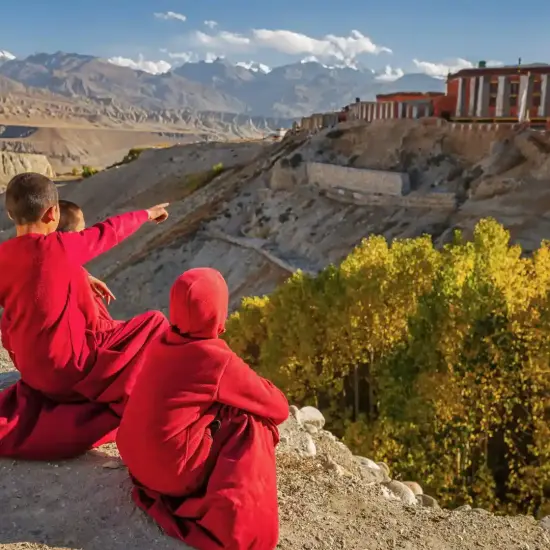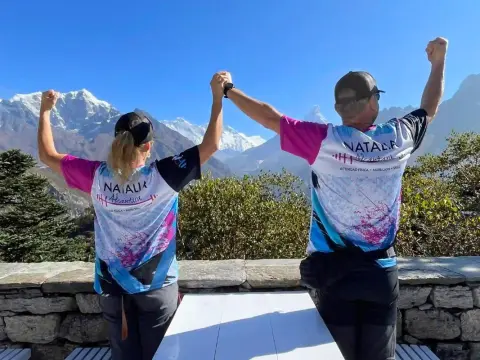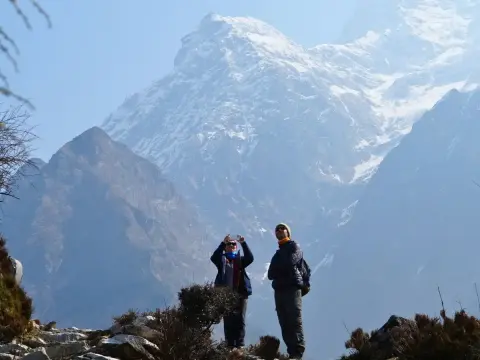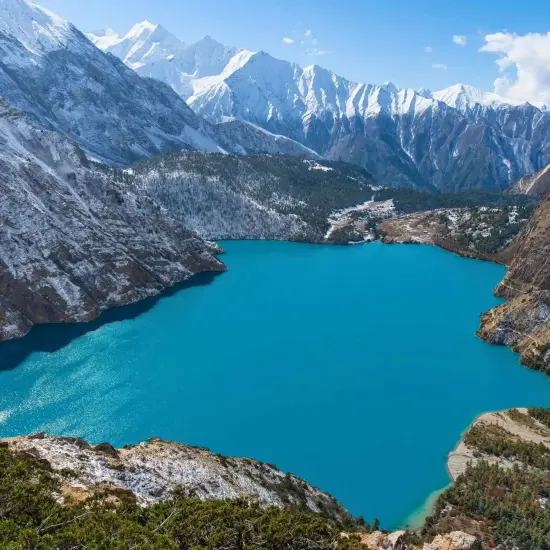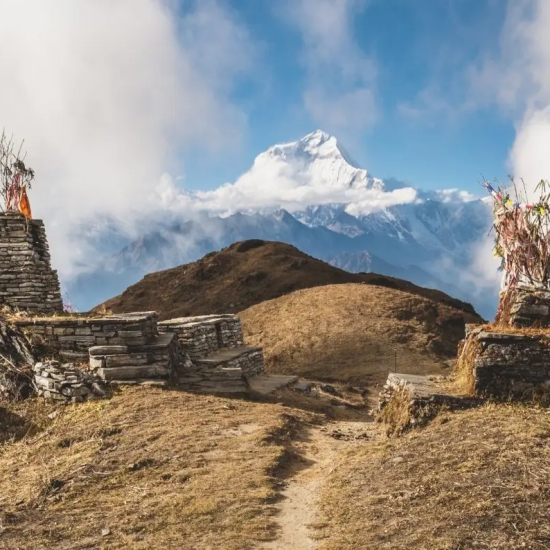The Langtang Valley Trek offers a mix of Himalayan adventure, local culture, and peaceful landscapes—just a few hours’ drive from Kathmandu, without the need for domestic flights.
Despite its proximity to the capital, the views are just as dramatic as on more remote trails, with majestic peaks like Langtang Lirung (7,245m), Dorje Lakpa (6,990m), and Langtang Ri (6,370m) towering above deep valleys and lush forests.
Whether you're an experienced hiker or a first-time trekker, each day brings a rewarding routine filled with scenic beauty, local hospitality, and moments of peaceful walking through rhododendron forests, riversides, and alpine meadows.
Why Choose the Langtang Valley Trek?
The Langtang Valley Trek is perfect for those seeking a shorter, quieter alternative to Everest or Annapurna, without compromising on natural or cultural richness.
Whether you're drawn by mountain views, traditional lifestyles, or peaceful wilderness, this trek offers it all in just 8 days.
1. Stunning Himalayan Views from Kyanjin Ri (4,700m)
One of the major highlights of the Langtang trek is the climb to Kyanjin Ri at 4,773 meters. From the summit, trekkers are treated to panoramic views of towering peaks such as Langtang Lirung (7,227m), Dorje Lakpa (6,990m), Langtang II (7,200m), and the Ganesh Himal range.
The sunrise and sunset views from this point are truly unforgettable.
2. Authentic Tamang and Sherpa Culture
The Langtang region is home to the Tamang and Sherpa communities, whose Tibetan-influenced culture adds rich depth to the journey.
Traditional stone villages, ancient monasteries, prayer wheels, and colorful mani walls offer cultural immersion that few other treks can match. Exploring Langtang village provides an authentic experience of Himalayan lifestyle and hospitality.
3. The Famous Yak Cheese in Kyanjin Gompa
Kyanjin Gompa, a scenic village near the end of the trek, is known for its traditional yak cheese factory.
Trekkers can sample fresh, organic yak cheese made by local artisans using age-old techniques—a delicious reward after several days on the trail.
4. Forest Trails and Rare Flora
The trail winds through dense forests of rhododendron, pine, bamboo, and juniper. In spring, the blooming rhododendrons paint the trail with vibrant colors.
The Langtang region is also rich in medicinal herbs and alpine plants, making the walk both scenic and healing.
5. Natural Beauty Beyond Mountains
Beyond the peaks, Langtang is a paradise for nature lovers. Flowing mountain streams, waterfalls, deep gorges, and rocky cliffs create a dramatic and magical landscape. The ever-changing terrain keeps each day of the trek exciting and visually stunning.
Permits Required for the Langtang Valley Trek
To trek in the Langtang region, you will need the following permits:
Langtang National Park Entry Permit – Required to access and support conservation in this protected area.
TIMS Card (Trekkers' Information Management System) – A safety registration card that tracks your trek for emergency support.
Places Nepal will arrange all permits in advance, ensuring a hassle-free start to your adventure.
Food and Accommodation on the Langtang Valley Trek
At Places Nepal Treks, we maintain close relationships with trusted teahouses to ensure quality food and clean accommodation throughout your journey. Our guides also help you choose the best spots for comfort and taste.
Accommodation and meals along the Langtang Valley Trek are simple yet comfortable. Most overnight stops offer teahouses—local lodges run by mountain families that provide essential lodging and home-cooked meals. While amenities are basic, the warmth and hospitality make every stop memorable.
Teahouse Accommodation
You’ll typically stay in twin-sharing rooms with basic furnishings, two single beds, a table, and bedding (mattress, pillows, blanket, and sheets).
At lower altitudes, some rooms may include attached bathrooms, while higher up, shared toilets are more common. Most teahouses have a central dining hall with a fire stove for warmth, where trekkers gather for meals and social time.
Facilities such as hot showers, Wi-Fi, and device charging are available in many lodges for a small fee. Note that amenities may become limited as you gain altitude.
Meals on the Trek
Food is freshly prepared and offers both local and international options. The staple meal is Dal Bhat—steamed rice with lentil soup and seasonal vegetables; served in unlimited portions, perfect for replenishing your energy.
You’ll also find options like:
Noodles and soups
Pasta, macaroni, and spaghetti
Pancakes, toast, and eggs
Tibetan bread, momos (dumplings), and fried rice
Prices increase with altitude due to transportation difficulty, but the meals are nourishing and hygienic.
Langtang Route & Altitude Highlights
Your trek begins with a scenic drive from Kathmandu to Syabrubesi (1,460m), a riverside town that serves as the gateway to Langtang National Park.
The trail follows the Langtang Khola upstream through lush subtropical forests filled with rhododendrons, bamboo, and pine. As you gain elevation, the air cools and the scenery transitions to alpine landscapes.
You’ll pass through charming Tamang villages such as Lama Hotel and Langtang Village (3,430m), where traditional stone houses sit against dramatic mountain backdrops.
The people here share deep cultural ties with Tibet, which is reflected in their language, dress, and Buddhist customs.
Tragically, Langtang Village was destroyed by a landslide during the 2015 earthquake, but has since been rebuilt and remains a symbol of strength and resilience. Trekking through this village is both a moving and inspiring experience.
Further up the valley, you’ll arrive at Kyanjin Gompa (3,870m), a peaceful village surrounded by glaciers and jagged peaks. Here, you can explore the sacred Kyanjin Monastery, sample yak cheese at the local factory, and acclimatize in preparation for optional hikes to Kyanjin Ri (4,773m) or Tserko Ri (5,000m) for truly panoramic Himalayan views.
After spending time in Kyanjin, you’ll retrace your steps back down the valley, soaking in the same rich beauty from a different perspective before returning to Kathmandu by road.
Best Time to Trek Langtang Valley
Langtang Valley’s trail can be explored year-round, choosing the right season ensures you enjoy the best weather, views, and trail conditions with fewer challenges.
Ideal Seasons for the Langtang Trek
The best time to trek Langtang Valley is during the autumn (September to November) and spring (March to May) seasons.
During these months, the weather remains clear, dry, and stable, with daytime temperatures ranging between 10°C to 15°C. The skies are generally cloud-free, offering uninterrupted views of the Langtang Lirung (7,227m), Ganesh Himal, and Dorje Lakpa ranges.
In spring, the trails are adorned with blooming rhododendrons, wildflowers, and vibrant greenery—perfect for nature lovers and photographers.
In autumn, post-monsoon clarity delivers crisp mountain views and a refreshing trekking atmosphere.
These seasons also align with Nepal’s festive period, so you may witness local celebrations along the trail. However, due to popularity, expect moderate foot traffic.
Off-Season Trekking in Langtang
If you prefer fewer crowds, winter (December to February) and monsoon (June to August) are also possible with the right preparation:
Winter brings cold mornings and snow-covered trails, but rewards you with solitude and crystal-clear skies.
Monsoon involves rain, muddy paths, and occasional landslides—but the landscapes are lush and serene.
In either case, having proper trekking gear and flexibility in your plans is essential.
Local Expertise from Places Nepal Treks
No matter the season you choose, the experienced guides at Places Nepal Treks are trained to ensure a safe, enjoyable, and memorable journey.
We monitor weather conditions closely, help you prepare with proper packing lists, and customize your trek to match your comfort level and expectations.
Langtang Valley Trek Difficulties – What You Should Know
The Langtang Valley Trek is a moderately easy trek, ideal for trekkers with basic fitness. While it's not technical, you should be aware of a few key difficulties:
1. Trail Distance & Terrain
You’ll cover around 80 km over 7 days, with daily hikes lasting 6–7 hours. Expect uphill climbs, rocky trails, and changing elevation. Regular walking or cardio training beforehand is recommended.
2. Altitude Sickness
The trek reaches up to Kyanjin Ri (4,773m), where AMS (Altitude Mountain Sickness) can be a risk. Symptoms may include headache, nausea, or dizziness. Go slow, stay hydrated, and inform your Places Nepal Treks guide immediately if you feel unwell; our guides are trained in first aid and AMS response.
3. Weather Challenges
Weather in Langtang can be unpredictable. Sudden rain, snow, or cold winds may occur, especially in winter or monsoon seasons. Pack warm layers, rain gear, and stay updated with our team’s daily briefings.
Do I Need a Porter for the Langtang Valley Trek?
While the Langtang Valley Trek is moderately easy to challenging, hiring a porter can greatly enhance your trekking experience. At Places Nepal Treks, our 8-day Langtang itinerary offers porter service for added comfort and support.
Why Hire a Porter?
Porters carry your main backpack (up to 20 kg), allowing you to hike with a light daypack containing essentials like water, sunscreen, snacks, layers, and personal items. This reduces fatigue and lets you focus on the stunning views, local culture, and the trail ahead.
Hiring a porter also supports Nepal’s mountain communities. Many porters are locals from the Langtang region who depend on trekking jobs for their livelihood. Your decision helps sustain families and the local economy.
Porter Guidelines:
Pack light: We provide a duffle bag designed for the porter to carry comfortably.
Respect the weight limit: One porter carries max 20 kg (usually for 2 trekkers).
Carry your own daypack: Porters often walk ahead to the next teahouse.
Be respectful: Porters are vital to Nepal’s trekking culture—treat them kindly.
Tipping Guide:
While not mandatory, tipping is a respected tradition in Nepal. A fair tip shows gratitude:
Tip directly at the end of the trek in NPR or USD. A handshake and thank-you go a long way.
Whether you're trekking in a group or privately, Places Nepal Treks ensures ethical treatment and fair pay for all staff. Hiring a porter isn’t a luxury—it’s a responsible, empowering choice that benefits both you and the mountain communities where paid jobs are limited.
Safety and Security on the Langtang Valley Trek
Nepal is one of the safest destinations for trekking, and the Langtang Valley Trek is no exception. Known for its friendly locals, peaceful trails, and strong trekking infrastructure, it offers a secure environment for solo travelers, groups, and families alike.
General Safety in Nepal:
Nepalese people are warm, welcoming, and highly respectful toward visitors.
Crime rates in trekking areas are very low.
Tourist police and local authorities are active in major trekking regions.
Be mindful in cities like Kathmandu—avoid walking alone late at night and keep valuables secure.
Safety on the Langtang Trek:
At Places Nepal Treks, your safety is our top priority. Our guides are licensed, experienced, and trained in first aid and altitude-related care. Here’s how we keep you safe on the trail:
Daily health checks and altitude monitoring by your guide.
Emergency support and 24/7 contact with our Kathmandu team.
Helicopter evacuation coordination in case of emergencies (travel insurance with high-altitude coverage is mandatory).
Well-planned itineraries with proper acclimatization and rest days.
Reliable communication and assistance on remote trails.
Solo and Female Travelers:
Langtang is considered safe for solo and female trekkers. For added comfort, Places Nepal Treks can arrange a female guide upon request. Our team also provides regular check-ins and on-trail support.
Tips for Staying Safe:
Always listen to your guide—they know the terrain and conditions.
Stay hydrated and pace yourself to avoid altitude sickness.
Carry your own first aid kit with personal medications.
Follow local rules and respect mountain culture and wildlife.
Avoid wandering off the trail alone, especially at high altitudes.
Transportation for the Langtang Trek – Access to the Starting Point
Langtang Valley Treks start from Syabrubesi, a charming village north of Kathmandu. Getting to Syabrubesi is easy via local bus, shared jeep, or private jeep, with the journey taking about 7 to 9 hours depending on road and traffic conditions. The drive offers stunning views of terraced hills, traditional villages, and rural Nepalese landscapes.
Private Jeep – Comfortable and Flexible
A private jeep is the most comfortable and convenient option fo Langtang trek. It can pick you up directly from your Kathmandu hotel early in the morning (around 7:30–8:00 a.m.) to avoid traffic and allow a scenic lunch stop on the way.
This option is ideal for families, groups, or travelers who prefer a smoother ride. The cost can be shared among 4 to 6 passengers, making it affordable and practical.
Local Bus – Budget-Friendly and Authentic
For budget travelers, local buses depart daily from Kathmandu’s Bus Park. Though inexpensive, these buses are often crowded, slower, and less comfortable, with basic seating and frequent stops. It’s a great way to experience local culture but requires patience, an early start, and snacks for the trip.
Return Transfers
Your return from Syabrubesi to Kathmandu follows the same route. Whether you book a private jeep or take a local bus, Places Nepal Treks will assist in coordinating your transportation.
For private jeep users, pick-up will be arranged directly from your Syabrubesi teahouse for a hassle-free end to your trek.
Food on the Langtang Trek: What to Expect
Food is a big part of the Langtang trekking experience. While meals are simple and locally sourced, they’re fresh, filling, and suited for high-altitude trekking.
All meals—breakfast, lunch, and dinner—are included in our 8-day Langtang Trek package with Places Nepal Treks.
The Langtang Valley Trek may be close to Kathmandu, but it still offers a quiet, less commercial trekking experience. That means while teahouses provide hearty meals, the menus are simpler than those on busier routes like Everest or Annapurna.
Typical Meals on the Trail
Dal Bhat (Rice, Lentil Soup & Veggies)
The classic Nepali trekking meal. It's all-you-can-eat and provides the perfect energy boost.
Breakfast Options
Tibetan bread or chapati with jam, peanut butter, or honey
Porridge (with apple, cinnamon, or honey)
Pancakes (plain, chocolate, banana, apple)
Eggs (boiled, scrambled, fried, or omelet)
Tea, coffee, or hot lemon
Lunch & Dinner Options
Dal Bhat (always available and recommended)
Fried noodles or rice with vegetables or egg
Momos (Tibetan dumplings)
Vegetable or egg curry
Pasta, spaghetti, macaroni
Sherpa stew or Thukpa (Tibetan noodle soup)
Snacks & Drinks
Along the trail, teahouses also offer:
Tea (milk tea, masala, ginger, mint)
Instant coffee or hot chocolate
Bottled water (available but expensive—bring purification tablets or a filter)
Biscuits, chocolate bars, chips, and soft drinks
Dietary Restrictions
Vegetarian meals are widely available. Let us know in advance if you require vegan, gluten-free, or other dietary options—our guides will help communicate with teahouses to accommodate your needs.
Hydration is Key
Staying hydrated is just as important as eating well, especially at altitude.
Drink 3–4 liters of water per day.
Avoid alcohol and excess caffeine.
Use purification tablets, SteriPEN, or ask for boiled water—tap water is not safe.
Carry two refillable bottles or a 2–3L hydration bladder.
Bring electrolyte tablets or rehydration salts.
Bottled water is available but expensive and not eco-friendly—we recommend purifying local water instead.









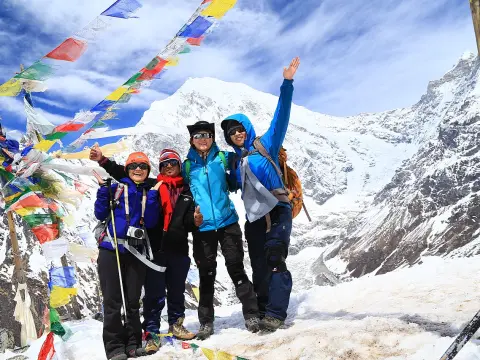

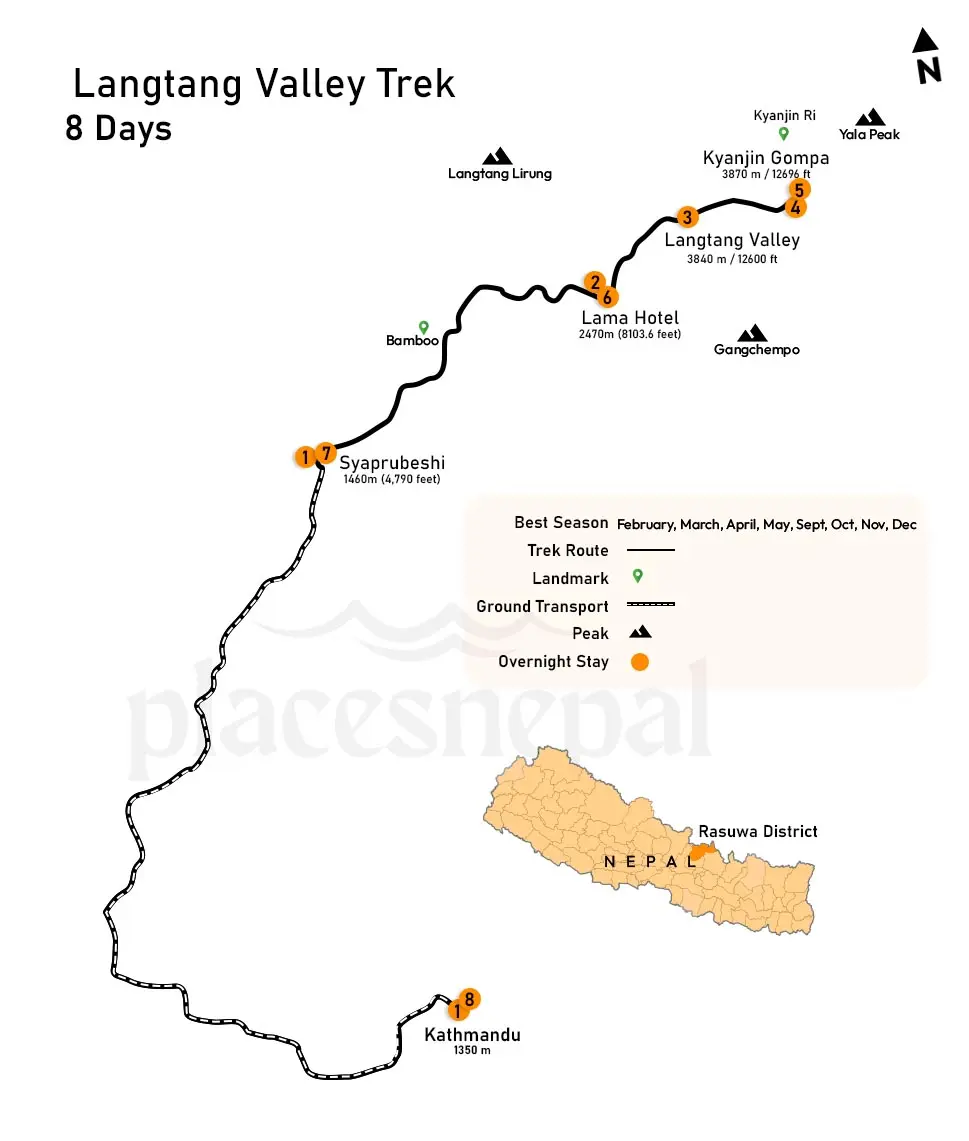
 Trek Difficulty
Trek Difficulty  Best Time to Trek Langtang
Best Time to Trek Langtang -webp.webp) Trek Permit Required
Trek Permit Required  Accommodation
Accommodation  General FAQs
General FAQs -webp.webp) Transportation
Transportation  Packing and Prep
Packing and Prep -webp.webp) Langtang Trek Guide
Langtang Trek Guide  Health and Safety
Health and Safety  Foods on the Trek
Foods on the Trek -webp.webp) Booking and Cancellation
Booking and Cancellation  Langtang Trek Cost
Langtang Trek Cost 









































